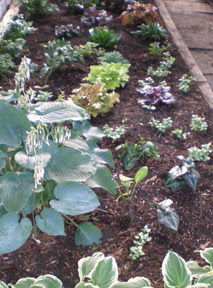Garden Walk boot camp

Actually, I wasn't the one who used this phrase—it was another gardener I interviewed for the book. But the routine she described is not unlike what we all have to do before opening the gates for this event.
Weeding is huge. There can be nothing coming through the flagstones or in mulched areas between plants. Where the plants are tight, a few weeds aren't going to be too noticeable. Then the mulching. I try to find a fine, undyed mulch that's still pretty dark. Then the deadheading—usually just daylilies, lilies, and annuals need this at this time. The wisteria and the mock orange have to be trimmed back, and anything tall has to be staked, if necessary. Now we also have the pond to clean out; the wisteria leaves have a way of rotting in the corners of the stones. The edges of the beds are trimmed so there aren't too many plants overflowing their boundaries. And so visitors have a clean walkway.
Another thing we did this year is clear out a bed of pachysandra (the previous owners couldn't get enough of this plant) and replant it with shade perennials (above). I have high hopes for some double hellebores, gingers, and heuchera, some of which I picked up during a recent visit to Plant Delights in North Carolina. Of course these plants won't impress the flower junkies.
Gardeners have to weed, mulch, trim, and replant all the time. But it's actually kind of nice to have a target date like Garden Walk to aim for. Keeps us on our toes.

Comments
Carol at May Dreams Gardens
doubt if we will get to every garden but we will not mock weeds or a dead flower missed.
at some point I wish you can say "good enough" and sit back and rest a bit before having to greet all of us.
Hey, did you know Elizabeth has a pink flamingo?!
When the Austin garden bloggers visited each other's gardens this spring, we all did some extra tweaking and then were happy to meet.
Y'all are going to have so much fun!
Annie at the Transplantable Rose